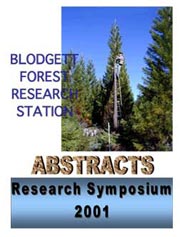ABSTRACT 7
Temporal and spatial variability in aquatic insect assemblages:
Implications for biological monitoring
Rosalie B. del Rosario and Vincent H. Resh
|
|
|
 Aquatic insects are commonly used as biological indicators of water quality. The underlying premise in their use is that changes in their assemblages may indicate anthropogenic impacts to stream ecosystems. We examined a fundamental assumption in biological assessments: that aquatic organisms in undisturbed streams are temporally persistent. We also addressed the validity of using several independent streams as spatial replicates in biological assessments. Lastly, we estimated ranges of biological measures against which future planned or unplanned disturbances at Blodgett Forest Research Station can be measured. Aquatic insects are commonly used as biological indicators of water quality. The underlying premise in their use is that changes in their assemblages may indicate anthropogenic impacts to stream ecosystems. We examined a fundamental assumption in biological assessments: that aquatic organisms in undisturbed streams are temporally persistent. We also addressed the validity of using several independent streams as spatial replicates in biological assessments. Lastly, we estimated ranges of biological measures against which future planned or unplanned disturbances at Blodgett Forest Research Station can be measured.
Using four years of data collected from nine sites in six streams draining unimpaired catchments at Blodgett Forest, we detected significant temporal and spatial variability in aquatic insect assemblages. In particular, assemblages collected in 1995 were distinct from the other three years (1996-1998), which may be explained by the low flow year in 1994. Comparisons of assemblages were conducted at three spatial scales: 1) upstream and downstream sites; 2) adjacent streams; and 3) four streams draining a catchment. Insect assemblages were variable, and there was no distinct pattern across space or time. The ability of using independent streams as replicates decreased with the number of streams examined. The use of a Before-After-Control-Impact-Pairs (BACIP) design is described as a means to control for natural temporal and spatial variability in insect assemblages. The inclusion of several years of baseline data in a BACIP study would allow for resource managers to distinguish ecological from statistical significance of a potentially impairing anthropogenic disturbance (e.g., prescribed burns) to stream ecosystems.
|
Contact Author: Rosalie B. del Rosario, Division of Insect Biology, 201 Wellman Hall, University of California, Berkeley, CA 94720, (510) 642-5913, email: rosalie@nature.berkeley.edu
|
|
|

 Aquatic insects are commonly used as biological indicators of water quality. The underlying premise in their use is that changes in their assemblages may indicate anthropogenic impacts to stream ecosystems. We examined a fundamental assumption in biological assessments: that aquatic organisms in undisturbed streams are temporally persistent. We also addressed the validity of using several independent streams as spatial replicates in biological assessments. Lastly, we estimated ranges of biological measures against which future planned or unplanned disturbances at Blodgett Forest Research Station can be measured.
Aquatic insects are commonly used as biological indicators of water quality. The underlying premise in their use is that changes in their assemblages may indicate anthropogenic impacts to stream ecosystems. We examined a fundamental assumption in biological assessments: that aquatic organisms in undisturbed streams are temporally persistent. We also addressed the validity of using several independent streams as spatial replicates in biological assessments. Lastly, we estimated ranges of biological measures against which future planned or unplanned disturbances at Blodgett Forest Research Station can be measured.